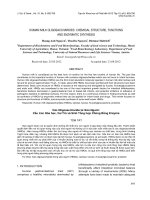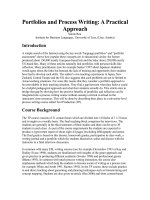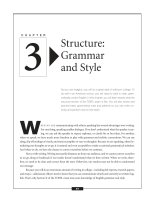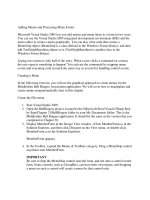Tourism policy structure content and process
Bạn đang xem bản rút gọn của tài liệu. Xem và tải ngay bản đầy đủ của tài liệu tại đây (123.53 KB, 11 trang )
TOURISM POLICY STRUCTURE CONTENT AND PROCESS
1. Tourism Policy: A Definition
- A set of regulations, rules, guidelines, directives, and development/promotion
objectives and strategies that provide a framework within which the collective and
individual decisions directly affecting long-term tourism development and the
daily activities within a destination are taken.
- The purpose of tourism policy: to seek to ensure that visitors are hosted in a way
that maximizes the benefits to stakeholders while minimizing the negative effects,
cost, and impacts associated with ensuring the success of the destination.
- Tourism policy is very important because it affects the extent to which all the day-
to-day operational activities of toursim, such as marketing, event development,
attraction operations and visitor recetion programs are successful.
2. The focus of tourism policy : The competitive/sustainable destination
Tourism destinations aredefined in terms by recognized political jurisdictions:
• A nation/country
• A macroregion, consisting of several countries/ other groupings
• A province/state within a country
• A localized region within a country
• A city/town
• A unique locale, such as a national park/a historic site …
3. The major parameters of tourism destination management:
The competitiveness of a destination refers to its ability to compete effectively and
profitably in the tourism marketplace. Sustainability pertains to the ability of a
destination to maintain the quality of its physical, social,cultural and environmental
resources while it competes in the marketplace.
Successful TDM involves traditional economic/ business management skills balanced
with environmental management, capabilities. The economic business skills required are
those related to effective resource development and deployment. The include strategic
planning for destination development, the marketing of the destination , the management
of the human resourece necessary to deliver quality visitor experience, the management
of the financial resources/investment required to support development, and the ability to
develop the organizational capacity to coordinate and ensure the delivery of essential
services.
The concept of stewardship has been expanded to encompass management practices
designed to both maintain and enhance the commemorative, social, and cultural integrity
of the destination
This human presence has two main compenents: visitor management and
resident/community management.
The tasks of resource deployment and resource stewardship are linked by the shared
need for a tourism destination management information system (TDMIS) to support
policy formulation, strategic planning, day to day decision, making and overall
performance evaluation
Policy research seeks to gather and interpret macrolevel data related to present values and
the evolution of trends of major economic, social, technological, and political factor that
bear on the success of the destination.
3.1 A model of the competitive/sustainable destination
The purpose of tourism policy is to ensure a common, agreed upon purpose for tourism
and to establish the broad parameters for planning and coordinating the efforts of all
tourism stakeholders
3.2 A warning: tourism destination and tourism policy do not exist in a vacuum
Tourism policies are but part of the social, economic, and political policies that govern
and direct the functioning of the overall society within which tourism exists and
functions.
In brief, a number of more general policies ( regulation, rules, directives, objectives,
strategies) are controlled by governments, as well as other industry sector and
organization, and these policies may have a significant effect on the success of tourism
and tourism destinations. These includes:
• Passport and visas • Education policy
• Taxation • Cultural policy
• Interest rate policy • Foreign investment policy
/regulations
• Environmental policy • Local zoning policy/bylaw
• Customs and immigration policy • National/provincical/ local policy
pertaining to funding support for
major public facilities
• Communications policy • Unfrastructure policy
• Minimum wage policy • Currency exchange – rate policies –
directly affect destination cost
competitivenesse
• Welfare policy • Legal system
To summarize, a whole range of social, economic,legal and technological policies
greatly affects the appeal, attractiveness, competitiveness and sustainability of tourism
destionation.
The challenge facing tourism managers is to try to influence global policies where
they can, and adapt to them as effectively as possible where they cannot
3.3 The Many Influences on Tourism Policy
Tourism does not exist in a vacuum. It can function smoothly only if it shares, cooperates
and dialogues effectively with many other sectors of society and of the economy.
Each of these interfaces can pose either a threat or an opportunity for tourism. The
environment sector and the extractive industries have traditionally viewed tourism as a
competing force, the technology, entertainment, and transportation sectors most often
perceive tourism as an ally or business opportunity.
In order to dialogue and to present its case effectively at each interface, the tourism sector
must be a capable, as well trained, and as well prepared as the professionals of any
specific sector at any given point in time
3.4 The Multidisciplinary Nature of Tourism and Tourism Policy
Tourism is a multidisciplinary phenomenon ( see Figure 1.3). the tourism experience is
impacted by a range of economic,psychological, societal, technological, legal, and
political forces.
3.5 Some Other Characteristics of Tourism Policy
In addition to the multidisciplinary nature of tourism policy, it also possesses several
other essential characteristic:
• It must focus on macrolevel policies/ even transnational level.
• It must be designed to formulate policies having a long time perspective.
• It must concentrate on how critical and limited resources can best respond to
perceived needs and opportunities in a changing environment.
• It must recognize the intellectual nature of the process of policy formulation. As
such, it must incorporate tacit knowledge and personal experiences as important
sources of information
• It must encourage and stimulate organized creativity so as to avoid policies based
on stereotyped or outmoded perceptions.
• It must be constructed to permit and facilitate a continuing dynamic social process
requiring inputs from multiple sources.
• It must be break down the traditional boundaries between industry sectors in
tourism.
• It must relate policies of the tourism subsystem to those of the total socioeconomic
system of a nation or region of which it is a part
• It must acknowledge the destination roles of both competition and cooperation and
seek to identify situations where each is appropriate
4. Tourism Policy: Structure, Content and Process:
4.1 The Structure of Tourism Policy
Figure 15.5: Provides one framework for tourism policy (i.e., a set of guidelines for
successful destination development and operations).
Tourism Philosophy
Tourism Vision
Tourism Objectives
and Constraints
Supply Macromanagement Demand
Development Organizational Structure Development
Strategies Stratagies
Operational/Tactical Operational/Tatical
Supply Development Demand
Policies/Programs Development
Policies/program
4.1.1 Tourism Philosophy
_ An explicit tourism philosophy is an essential foundation on which to develop a
coherent policy
_ A philosophy may be defi ned as a system for guiding life — a body of principles of
conduct, beliefs, or traditions — or the broad general principles of a particular subject or
fi eld of activity. Íts purpose that indicates the beliefs and values of members of a society
concerning how tourism shall serve the population of a country or region.
_ Stress the critical role that the values of destination residents exert in determining the
context of tourism policy
_ Tourism policies that do not reflect the values of the destination stakeholders, or hosts,
will inevitably fail to gain ongoing popular or political support
4.1.2 The Destination Vision
Visions can take many different forms. Typically, however, a destination vision is
structured as shown in Figure 15.6 .
Destination Vision
– A Conceptual Framework -
Preamble
Core Vision
Elements
of the Vision
Ecology
Awareness
Visitor Experience
Economy
Community
Governance
VALUES
On which the Vision Is Based
PRINCIPLES
Guiding Implementation of Vision
_ The preamble sector of a vision sets the tone and provides the context and
rationale for the vision being developed.
_ The core vision, as the name implies, attempts to capture the overall essence of
the ideal future for the destination in question
_ The values component of the vision statement seeks to provide an understanding
of the deeply held enduring beliefs of the stakeholders formulating the vision
_ Once the core vision and its elements have been agreed upon, it is frequently
useful to provide a statement of principles designed to provide guidance as to how
the vision and its elements should be interpreted and implemented.
4.1.3 Crafting versus Formulating a Strategic Vision
_ Policy formulation is a term refl ecting a traditional approach to strategic
planning that can be described as prescriptive in orientation
_ Crafting a strategy is a dynamic, evolving process in which strategies take form
as a result of learning over a period of time, as opposed to being formulated at a
fixed point in time.
_ Crafting strategy requires dedication, experience, involvement with the material,
the personal touch, mastery of detail, a sense of harmony, and integration
4.1.4: Tourism Objectives and Constraints
_Component three of a tourism policy consists of a statement of the objectives of
the tourism system
_ The objectives of the tourism system should possess a number of important
characteristics
First, because the objectives are formulated in light of the tourism vision, their
achievement should clearly contribute to the fulfi llment of this vision
Second, in order that the objectives can be qualified as operational, it is essential
that managers are able to measure the extent to which desired results have or have
not been attained
Third, we must ensure that the measures selected with respect to each objective are
indeed valid indicators of the desired results; that is, they must measure what we
truly want to achieve.
Fourth, in the common situation where the tourism system has multiple objectives,
it is advisable to indicate an order or priority among objectives
Fifth, the objectives must be related to a given time period as is directly stated in
the above definition
Finally, the objectives that are stated must be reasonable
4.2 The Process of tourism policy formulation:
This process is conceptualized as containing distinct stages grouped into four main
phases (Figure 15.7 ). These phases are identified as the definitional phase, the analytical
phase, the operational phase, and the implementation phase.
4.2.1 Definitional Phase
_ Defi nition of tourism destination system
_ Explication of a tourism philosophy
_ Crafting of a destination vision
_ Objectives and constraint
The definitional phase of tourism policy formulation is concerned with the development
of explicit statements that defi ne the content and direction of the overall tourism system
in question.
The remaining three components of the defi nitional phase (Figure 15.7 ) involve the
explication of a tourism philosophy, the formulation of a destination vision, and the
determination of tourism objectives and constraints for the destination
4.2.2 Analytical Phase
Internal Analysis
Review of existing policies and programs
Resource audit
Strategic impact analysis
External Analysis
Macrolevel analysis of current and future demand
Microlevel analysis of current and future demand and behaviors
Review of competitive and supportive tourism development and promotion policie
_ The analytical phase accepts these decisions as a given and proceeds to carry out
the extensive collection and assessment of information needed to identify and
assess the desirability of alternative means of attaining the destination vision and
to achieve the goals de ned by the vision.
_ The overall process of analysis is best viewed as being composed of two major
subprocesses: (1) an internal or supply - oriented analysis, and (2) an external or
demand - oriented analysis.
+ The internal/supply analysis consists of a thorough review and analysis
(frequently termed an audit ) of two major elements
The first element relates to existing policies and programs for the development of
the various components of tourism supply
A second element of the supply analysis is termed a resource audit . A resource
audit should be conducted with two goals in mind. First, it should provide
acomprehensive cataloguing of the quantity and distribution of tourism facilities
and services within the tourism system. Such information is basic to an
understanding of the current state of affairs of supply development. Second, the
resource audit should provide some assessment of the quality of existing facilities
and services.
The third form of internal analysis is a strategic impact analysis. This analysis
seeks to provide policy makers with well - defi ned benchmarks as to the extent to
which tourism is currently impacting the destination in economic, ecological,
social, and cultural terms.
+ The external/demand analysis is composed of three distinct types of analytical
Activity
The first involves macrolevel analysis of data that describes and defi nes the
overall nature and structure of current tourism demand as well as those markets
having a potential for future demand. This form of analysis relies heavily on
aggregate statistics measuring the flows of tourists and travel - relateexpenditures
within a region
The second type of external/demand analysis is termed microlevel analysis. Here,
rather than focusing on aggregate trends in tourism demand, attention is directed
toward gaining an understanding of the motivations and behavior of the different
segments of the total tourism market
The final component of external/demand analysis involves a review and evaluation
of competitive and supportive tourism development and promotion policies and
programs
4.2.3 Operational Phase
Identification of strategic conclusions
Implications of conclusions for supply and demand development
Policy/program recommendations
This operational phase is envisaged to contain three conceptually different types of
activity
The identifi cation of strategic conclusions flows directly out of the analytical phase,
and its goal is to synthesize the large amounts of information obtained into a limited
number of major conclusions. This process also must attempt to provide conclusions that
assess the impact of the trade - offs that inevitably are made when attempting to match
supply and demand.
The subsequent stage of the policy formulation process is the identifi cation of specifi c “
policy/program recommendations for supply/demand development. ”
4.2.4 Implementation Phase
Implementation of strategy for destination of development, promotion, and stewardship
Allocation of responsibilities for recommendation implementation
Identifi cation of sources of funding to support competitive initiatives and stewardship
programs
Specification of timing for recommendation implementation
Monitoring and evaluation of the results
Finally, for a destination tourism policy to truly succeed, it is essential to include
an implementation phase. At a minimum, such a strategy must: (1) identify the
individual groups or organizations that will assume responsibility for each major
dimension of the policy realization, (2) establish initial estimates of the fi nancial
requirements, and (3) provide preliminary timelines for the launching of all major
facilities, events, and programs that support the destination vision.
5. Translating policy into reality
- It must be emphasized that once overall supply-and-demand development
strategies have been enunciated and appreciate organizational structures put in
place.
- These strategies must be translated into specific policies and programs of an
operational nature.
6. Formulating policy to deal with crises
- Despite the best efforts to formulate tourism policies that support destination
development, to plan and execute the development of an attractive tourism
destination, and to effectively manage a tourism destination, sometimes the
unthinkable happens. Example: The September 11, 2001. Terrorist bombing of the
twin towers in New York and the Pentagon in Washington D.C; the 2002 bombing
of a tourist-filled nightclub in Bali so on.
- It is really important to manage cristic in tourism industry.
- Crisis – causing events are divided into 7 general types and/or categories of risk:
• Economic crises
• Informational crises
• Physical crises
• Human resource crises
• Reputation crises
• Crises resulting from psychopathic acts
• Natural disasters.
- The best method of crises management is preparation before a crisis occurs – first
implementing effort to prevent the crisis from occurring at all, and then
developing the ability to react immediately and effective should an outbreak or
incident arise.









